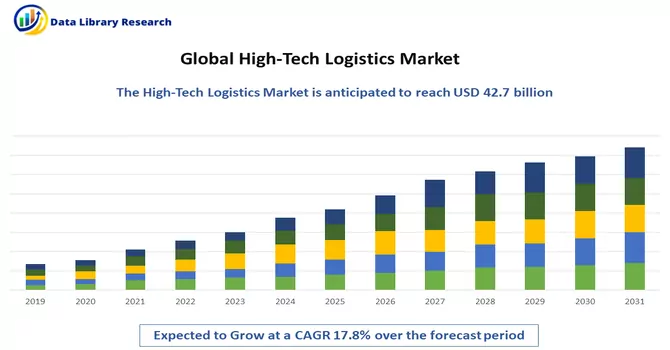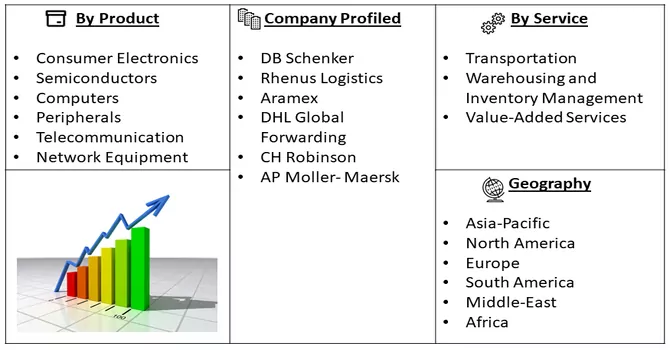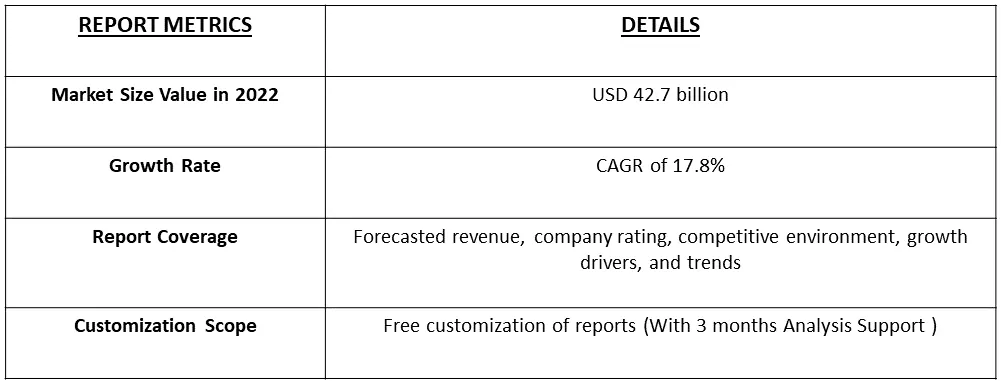The High-tech Logistics Market is currently valued at USD 42.7 billion in the year 2022 and is expected to register a CAGR of 17.8% over the forecast period, 2023-2030.

Get Complete Analysis Of The Report - Download Free Sample PDF
High-tech logistics, or "high-tech supply chain management" or "advanced logistics," refers to the application of cutting-edge technology and innovative solutions to optimize and enhance various aspects of the logistics and supply chain industry. This specialized approach incorporates a range of advanced tools, systems, and practices to improve the efficiency, visibility, and overall performance of the supply chain. High-tech logistics involves the integration of digital, technological, and data-driven solutions to address the challenges and complexities of modern supply chain management.
With the increasing importance of data and technology in logistics, security is a paramount concern and the expansion of global trade and supply chains has increased the complexity of logistics operations. High-tech solutions help manage global logistics networks and international shipping efficiently. High-tech logistics includes robust cybersecurity measures to protect sensitive information and systems. Thus, these marker drivers are expected to drive the growth of the studied market.
The adoption of digital technologies, such as the Internet of Things (IoT), blockchain, and advanced analytics, has enabled logistics companies to create more transparent and data-driven supply chains. This, in turn, leads to better decision-making, real-time tracking, and increased efficiency. The growth of e-commerce and online shopping has placed significant demands on logistics providers. Meeting the expectations of fast and convenient delivery has driven the need for innovative last-mile delivery solutions, including autonomous vehicles, drones, and smart lockers. Moreover, there is a growing emphasis on sustainability in logistics. High-tech logistics solutions are being used to reduce carbon footprints by optimizing routes, improving fuel efficiency, and reducing waste in the supply chain.
Segmentation:
The High-tech Logistics Market is Segmented
By Service :
Product Category :
Geography :

For Detailed Market Segmentation - Download Free Sample PDF
Drivers:
Exponential Growth of E-commerce
The exponential growth of e-commerce has been a defining feature of the modern business landscape. As consumers increasingly turn to online shopping for convenience, variety, and accessibility, the logistics industry has had to undergo a significant transformation to keep pace. High-tech logistics solutions have emerged as a direct response to the demands and challenges posed by the e-commerce boom. For instance, an article published by Journal of Business Logistics in April 2022, reported that global e-commerce market has experienced remarkable growth of 21.3% from 2017, with online retail sales continually climbing year after year. As a result, the volume of packages and parcels that need to be handled, sorted, and delivered has increased dramatically. High-tech logistics is crucial in managing this surge in demand efficiently. Thus, such factors are expected to drive the growth of the studied market over the forecast period.
Increasing Data Driven Decision Making
Data-driven decision-making has become a cornerstone of the high-tech logistics market, reshaping how companies manage their supply chains, optimize operations, and deliver goods to customers. In an era of digital transformation, the ability to collect, analyze, and act upon data has become a competitive advantage for logistics providers. Data-driven decision-making provides logistics companies with real-time visibility into their supply chains. Through the integration of data from various sources, including IoT devices, GPS tracking, and warehouse management systems, businesses can monitor the movement of goods at every stage of the supply chain. This visibility enables proactive issue resolution, accurate delivery time estimates, and better customer service. As a result, the market is expected to witness significant growth over the forecast period.
Restraints:
High-Tech Logistics Market High Implementation Cost of High-tech Logistics
The adoption of high-tech logistics solutions often requires substantial initial investments in technology, infrastructure, and workforce training. This cost can be a barrier for smaller logistics companies or those with limited budgets. As a result, the growth of the market is expected to slow down over the forecast period.
The COVID-19 pandemic presented unprecedented challenges to the high-tech logistics market, it also accelerated the adoption of advanced technologies and reshaped the industry. The pandemic underscored the importance of sustainability. High-tech logistics solutions were utilized to improve fuel efficiency, reduce emissions, and optimize routes for environmentally responsible transportation. With the increased reliance on digital technologies, logistics companies faced heightened cybersecurity risks during the pandemic. Ensuring data security and safeguarding critical infrastructure became top priorities, thus the market is expected to witness significant growth over the forecast period.
Segmental Analysis:
Warehousing and Inventory Management Segment is Expected to Witness Significant Growth Over the Forecast Period
High-tech logistics transforms warehousing and inventory management into data-driven, highly efficient, and responsive processes. These technologies not only improve the accuracy and speed of operations but also enhance overall supply chain performance and customer satisfaction. High-tech logistics streamlines the order fulfillment process through intelligent routing, inventory management, and real-time tracking. These technologies enable faster, more accurate order processing and ensure timely delivery to customers. Moreover, data analytics and machine learning tools are used to analyze historical data and forecast demand accurately. This helps logistics companies optimize inventory levels, align stock with consumer needs, and enhance inventory turnover. As a result, the segment is expected to witness significant growth over the forecast period.
Consumer Electronics Segment is Expected to Witness Significant Growth Over the Forecast Period
Consumer electronics are manufactured in diverse locations around the world. High-tech logistics is instrumental in managing the global supply chain, ensuring that components and finished products move seamlessly between factories, distribution centers, and retail outlets across international borders. Consumer electronics often involve a vast array of products with varying features, specifications, and demand profiles. High-tech logistics employs data analytics to optimize inventory management, reducing holding costs, preventing stockouts, and aligning stock with consumer preferences.
The high-tech logistics industry plays a pivotal role in the supply chain of consumer electronics, a sector characterized by rapid innovation, global distribution, and a constant demand for the latest gadgets. High-tech logistics, driven by cutting-edge technology and data-driven strategies, is essential for the efficient, secure, and cost-effective movement of consumer electronics. As a result the segment is expected to witness significant growth over the forecast period.
North America is Expected to Witness Significant Growth Over the Forecast Period
North America, comprising the United States, Canada, and Mexico, is a dynamic region that plays a pivotal role in shaping the high-tech logistics landscape. This vast and diverse area is home to numerous technological hubs, global supply chain networks, and rapidly evolving e-commerce markets. Moreover, North America is home to some of the world's most influential technological innovation hubs, such as Silicon Valley in California, the Research Triangle in North Carolina, and the Boston-Cambridge tech corridor in Massachusetts. These regions drive advancements in high-tech logistics systems and solutions, fostering collaboration between logistics providers and technology companies. North American logistics companies are at the forefront of adopting advanced warehouse technologies, such as robotics, automated material handling systems, and smart inventory management solutions. These innovations enhance efficiency and speed within the supply chain. As a result, the region is expected to witness significant growth over the forecast period.

Get Complete Analysis Of The Report - Download Free Sample PDF
The high-tech logistics market is fairly fragmented, with a good number of companies active in the market. To remain aggressive and improve performance, keeping up with modern technology is a necessity for the logistics players in the market. The companies are working on developing features like flexibility and openness to coordinated technological efforts as they explore the continually changing worldwide economy. The companies are also under significant pressure to manage costs and minimize time to market. Some of the key market players working in this market segment are:
Recent Developments:
1) March 2021: Rhenus High Tech joined TENESO, one of the largest cross-border high-tech transport companies in Europe, as a co-shareholder in the company, enabling the strengthening of its existing European network structures for high-tech logistics.
2) May 2020: cargo-partner, the international transport and info-logistics provider, set up a dedicated department for high-tech logistics at its headquarters near Vienna Airport. The services range from time-definite delivery with a dedicated vehicle fleet up to on-site installation, customer training, and specialized warehousing solutions.
Q1. What is the current High-Tech Logistics Market size?
The High-tech Logistics Market is currently valued at USD 42.7 billion.
Q2. At what CAGR is the High-Tech Logistics Market projected to grow within the forecast period?
High-Tech Logistics Market is expected to register a CAGR of 17.8% over the forecast period.
Q3. What segments are covered in the High-Tech Logistics Market Report?
By Service, By Product Category and Geography these segments are covered in the High-Tech Logistics Market Report.
Q4. What are the factors driving the High-Tech Logistics Market?
Key factors that are driving the growth include the Exponential Growth of E-commerce and Increasing Data Driven Decision Making.
Data Library Research are conducted by industry experts who offer insight on industry structure, market segmentations technology assessment and competitive landscape (CL), and penetration, as well as on emerging trends. Their analysis is based on primary interviews (~ 80%) and secondary research (~ 20%) as well as years of professional expertise in their respective industries. Adding to this, by analysing historical trends and current market positions, our analysts predict where the market will be headed for the next five years. Furthermore, the varying trends of segment & categories geographically presented are also studied and the estimated based on the primary & secondary research.
In this particular report from the supply side Data Library Research has conducted primary surveys (interviews) with the key level executives (VP, CEO’s, Marketing Director, Business Development Manager and SOFT) of the companies that active & prominent as well as the midsized organization
FIGURE 1: DLR RESEARH PROCESS

Extensive primary research was conducted to gain a deeper insight of the market and industry performance. The analysis is based on both primary and secondary research as well as years of professional expertise in the respective industries.
In addition to analysing current and historical trends, our analysts predict where the market is headed over the next five years.
It varies by segment for these categories geographically presented in the list of market tables. Speaking about this particular report we have conducted primary surveys (interviews) with the key level executives (VP, CEO’s, Marketing Director, Business Development Manager and many more) of the major players active in the market.
Secondary ResearchSecondary research was mainly used to collect and identify information useful for the extensive, technical, market-oriented, and Friend’s study of the Global Extra Neutral Alcohol. It was also used to obtain key information about major players, market classification and segmentation according to the industry trends, geographical markets, and developments related to the market and technology perspectives. For this study, analysts have gathered information from various credible sources, such as annual reports, sec filings, journals, white papers, SOFT presentations, and company web sites.
Market Size EstimationBoth, top-down and bottom-up approaches were used to estimate and validate the size of the Global market and to estimate the size of various other dependent submarkets in the overall Extra Neutral Alcohol. The key players in the market were identified through secondary research and their market contributions in the respective geographies were determined through primary and secondary research.
Forecast Model
